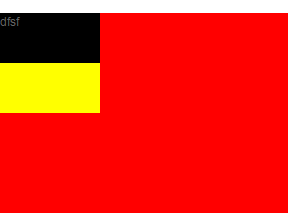.test{position: relative; 300px; height: 300px; background: red;}
.t2{position: absolute; 200px; height: 200px; background: black; top: 10px;left:10px;}
.t3{position: absolute; 100px; height: 100px; background: blue; top: 10px;left:10px;}
<div class="test"> <div class="t2"> <div class="t3"></div> </div> </div>

使用overflow 的结果,如下图:
.test{ 300px; height: 300px; background: red;position: relative;top:10px;left:10px;overflow: hidden;}
.t2{ 200px; height: 200px; background: black; position: absolute; top: 200px;left:10px;}
.t3{ 100px; height: 100px; background: blue; position: absolute;top: 10px;left:10px;}
<div class="test">
<div class="t2">
<div class="t3"></div>
</div>
</div>

ps:所以有绝对定位少用overflow
3. 绝对定位:以父节点为参考,如果不设位置,则默认是他原来的位置,相对定位是以原来的位置为参考
<div style="position: relative; background: red; 400px;height: 200px;"> <p style=" background: black; 100px;height: 50px;">dfsf</p> <div style="position: absolute; background: yellow; 100px;height: 50px;"> </div> </div>
